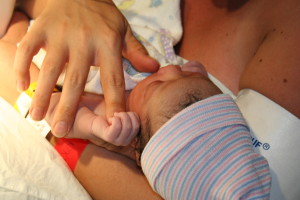My guest writer today is Martha, from Momsoap. She is one of my talented Austin-area blogging friends, frequently making me laugh out loud and think some deep thoughts within the same post. Today she is here talking about skin color – how we see it, whether we are comfortable talking about it. So what are you waiting for? Read on, friends…
***
White people are unbelievably uncomfortable talking about race or skin color.
This is a fact that I have become acutely aware of in the past three years. In part, my observation of this fact came about with my becoming more accustomed to using skin color as a qualifier for myself.
Annika notices and mentions often that I’m white. She has compared me to random people out in public. “Hey, she’s white like you mommy!”
She started out with almost the same skin color as mine.
She has noticed that her dad’s and her own skin colors are more alike than mine, and made sure to mention it. She’s also followed it up with assurance that she still likes me even though we’re different. That one was interesting to me because I’m not sure if she thought I’d be offended, or if she was repeating something she heard.
More importantly, an observation I’ve made over the past few years is that white people seem to think that their skin color is of no consequence, and when discussing skin color with their children, they must discuss other races’ skin colors, but not their own.
For quite some time now, I get questioned by my white friends about how to talk about skin color with their children. It’s something I am supposed to know about.
The truth is, I’m not more comfortable and I don’t know any better. I have just learned a few basic lessons. I can give a knowing nod. I have been known to roll my eyes about a typical white person faux pas. And I still make them too.
Something I have definitely learned is that white people have skin color too. We can talk about our own skin color.
When discussing skin color with your children, get comfortable with your own.
In general, other races don’t seem to have as much problem talking about race and skin color because they aren’t afraid to discuss their own. Because of our nation’s history, people of color have gotten used to being labeled with a skin color. White people, not so much.
To some, this might seem backward, going in a direction that many want to shy away from. White people who consider themselves enlightened and open to diversity will proudly point out that their children don’t notice skin color, or that it’s of little consequence. They lament the differences and wish for utter equality of the races, looking forward to a future when we are all the same, and when we are all truly equal.
While I agree with the latter part of that statement, I disagree that we must all be the same. Let’s embrace our differences and enjoy them. Let’s not assume that we must be the same in order to be equal. And let’s stop thinking of skin color as “theirs.” We have skin color too.
Ironically, when I first began to really ponder this idea, I finally understood why many black people will point out that their skin is not really black. My skin color is not actually white, but a very light shade of brown. Annika, at only 3, has emphatically pointed out to me that she is not black, but she is “light brown” and her daddy is “dark brown.” And while she calls me white, because that’s what she’s heard us say about my skin color, she has also noticed that I am just lighter brown than she is.
Maybe we aren’t so different after all.
I wonder…
:: What do you tell your children about skin color?
:: How do you view your own skin and what does it mean to you?
***
About the Writer
Martha Wood is the author of Momsoap. She is the mother of Annika, who is almost 4 and precocious as hell. Martha writes about many things, among them, she wonders about topics involving race and racism since Annika is biracial. You can fan her on Facebook, follow her on Twitter, and check out her boards on Pinterest.








 Lapsed homemaker. Looking to hire a full-time housekeeper who will work for the sheer joy of a job well done and free coffee. Interested parties, DM please.
Lapsed homemaker. Looking to hire a full-time housekeeper who will work for the sheer joy of a job well done and free coffee. Interested parties, DM please.
To answer your second question, currently I view my skin as angry because it’s breaking out like crazy. I don’t like it. No matter what shade it may be.
Thinking about discussing skin color with my kids, well, we’re pretty literal about it. Like your “light brown, dark brown” conversation. They have both been in daycare since infants and their primary caregiver there was Angele – from Senegal. She had the most beautiful creamy skin “like chocolate” they would say. We live in a pretty diverse area – and whenever they try to explain someone in their class, it’s rare that they use the skin color to describe them. It’s more “he’s really loud” or she has the short “swirly hair” or he has “spots” on his face (freckles).
For this – I’m grateful, because my own upbringing was the complete opposite.
Thanks for your comment Mommakiss! I think it’s great that your kids can discuss skin color with positive connotations. Like you said, it’s important to make the distinction. Skin color doesn’t have to be negative, which is why I believe it’s healthy and important to talk about it in every day life as just another identifier, just like “he’s loud” or “she’s got swirly hair” there’s nothing wrong with saying, “he’s got brown skin” or “she’s white.” Thanks for stopping by!
WOW! Loved this guest post. Thanks for “sharing her” with me 😉
Thanks Kate!
“Let’s not assume that we must be the same in order to be equal.” Love this!
I think our kids can be great teachers about how to see skin color as just that – skin color. We try to keep it a very matter-of-face discussion in our house and to point out all the shades around us. I just bought some great kids books about this! My oldest says “Daddy is brown, Mommy is tan, and I’m tannish-brownish.”
It’s interesting because my girls are the only kids in their MDO class who are not from India or the Middle East. But they don’t have a clue about any of that. They love their classmates and talk about them all the time. They don’t get that they have names that are different from the rest of us or care that their skin is darker. I love that.
Hey Leigh Ann, that’s very nice at preschool age, but what about as they get older? The research shows that it’s really important to discuss skin color with your kids so they get comfortable with more complex topics surrounding it as they age.
Here’s a really good article for reference: http://www.thedailybeast.com/newsweek/2009/09/04/see-baby-discriminate.html
My boy attends a very diverse daycare and preschool. He frequently says things like, I played with Jimmy today. He’s white. And then, we played with DJ. He’s black. So, we’ve talked about how people have different skin colors and then I try to just listen and not comment about it. There was only 1 time I was uncomfortable about it. My boy said, Mommy, there is a black man outside. So, I felt like I had to talk to him about how there’s much more to a person than their skin color, and we don’t have to identify them that way. I don’t know. It was hard to explain to him. I just hope that most people know that kids just speak honestly and aren’t intending to offend, and as they get older they will learn more of the nuances about what is “ok” or not.
My son is 3 and from out of nowhere he is aware of skin color. He says that I am pink and his dad is black:) Which, I guess is true. I’m not exactly white. We’ve been having lots of interesting conversations. Mostly, I am letting him lead the way. I’m learning from him.
It’s a terrific question. My daughter used to loudly point out skin color. Not because she thought any thing was wrong just observing. Her father and I, however, would wish the earth would swallow us up. Why? I’m not sure. She was simply being a toddler pointing out the obvious — that we all have differences. Why did we assume that different had to mean bad? Looking back, I think it was good. We talked at an early age that God made us all different. We pointed out that my husband (of Italian descent) had darker skin than I (of Irish and German descent).
On a happy side note, her favorite Disney princess is Tiana from the Princess and the Frog.
🙂
Traci